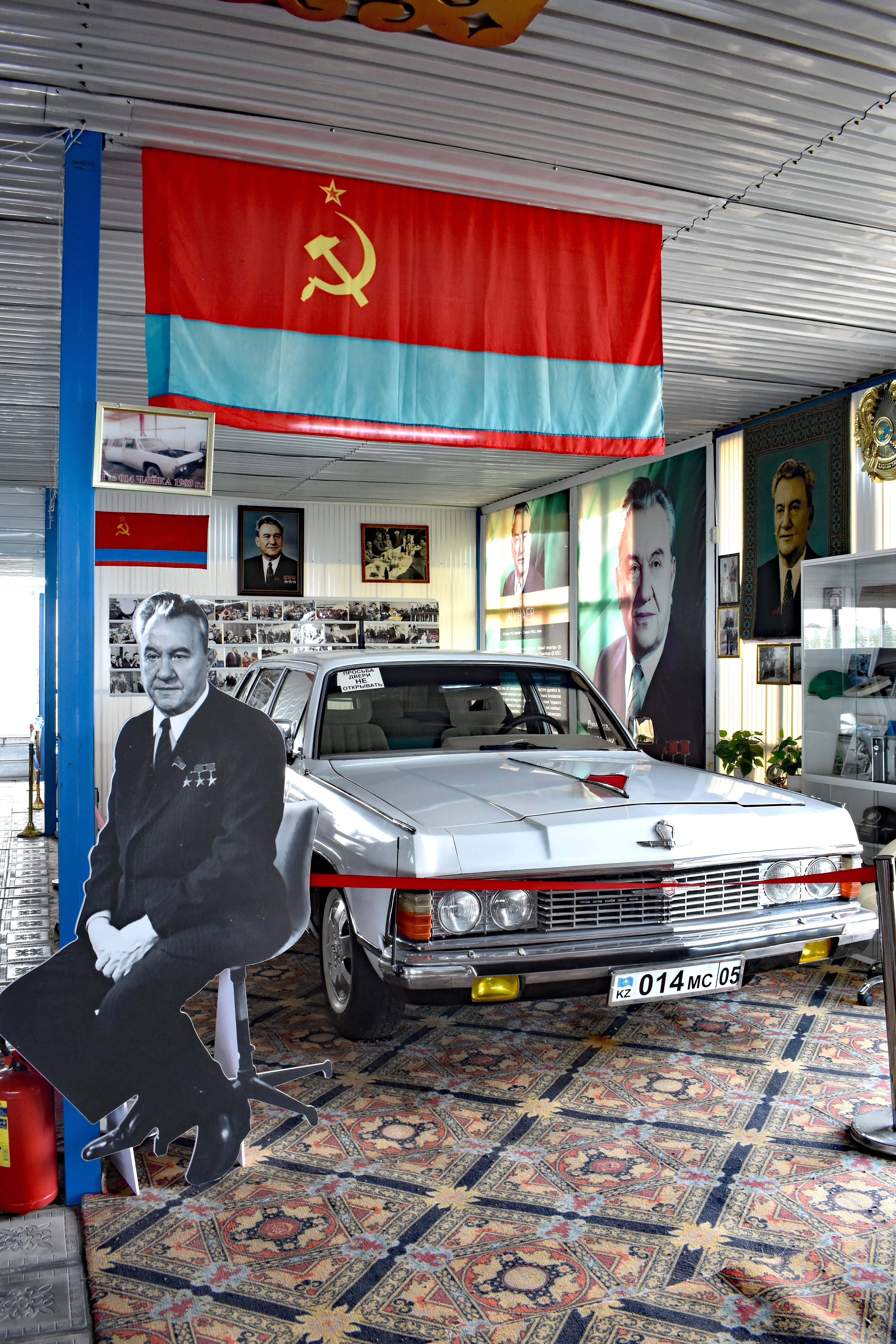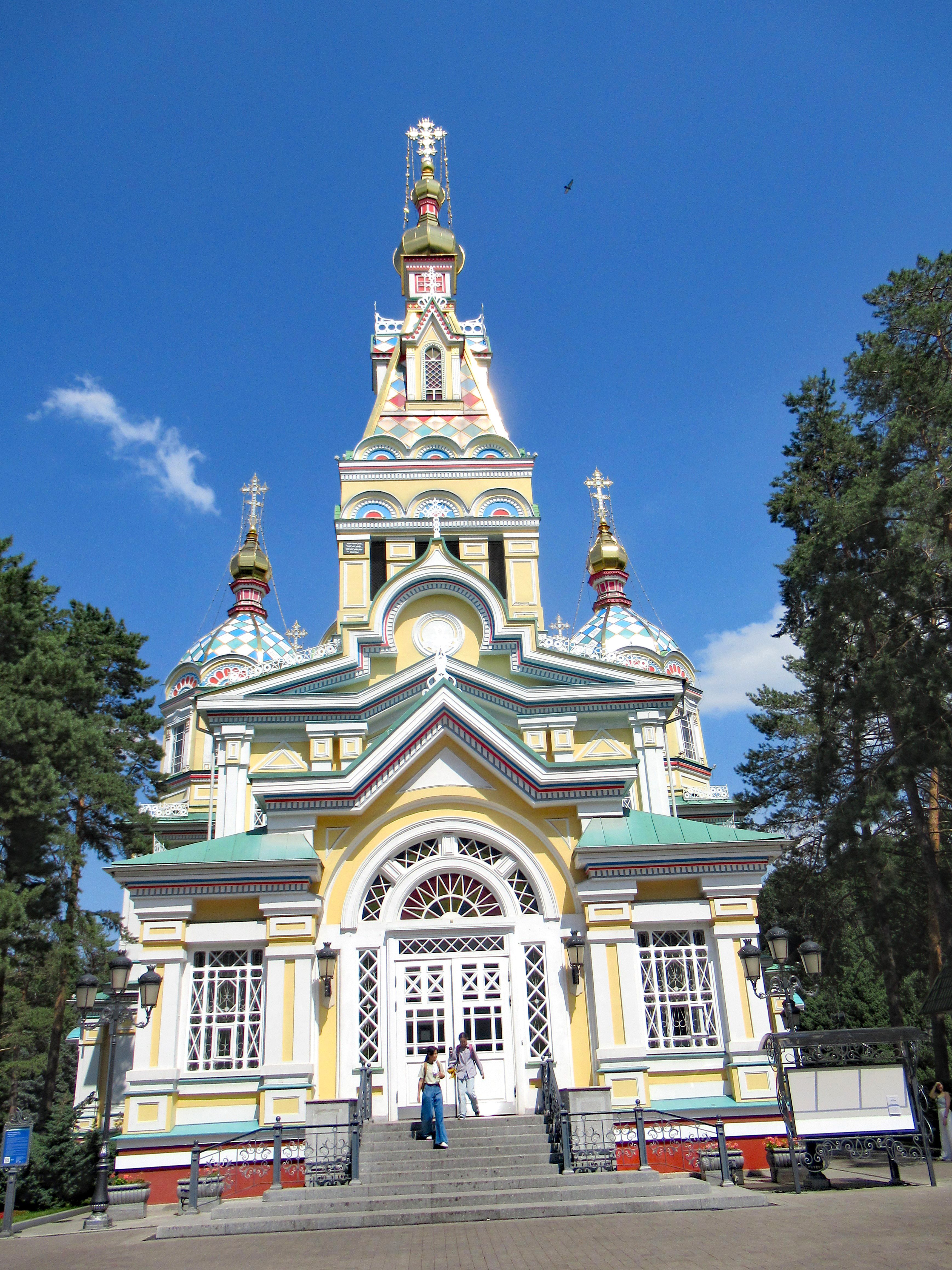Almaty, Kazakhstan’s largest metropolis, served as the country’s capital until 1997 and remains the country’s trading and cultural hub.
Before arriving in Almaty, we stopped in the town of Konayev, at the Tulpar Classic Car Museum. Our tickets were accompanied by two instructions: ‘don’t open the car doors’ and ‘don’t sit on the motor bikes’. You didn’t need to be a petrol head to enjoy the extensive array of Soviet era cars including Volga, Moskvitch, Zaporozhets, and the GAZ with its silver running deer on the bonnet. They ranged from very tiny cars to convertible stretched limos with red padded leather upholstery. One of the museum’s most prized possessions was the white Chaika car, used by Dinmukhamed Kunayev, the First Secretary of the Kazakhstan Communist Party, which had a life size cut out of him stood next to it. The display of motorbikes was similarly diverse with comfortable sidecars or space for two people to sit side by side behind. Some vehicles had photographs showing the condition in which they were discovered, but unfortunately signage was in Russian, or it would have taken longer as it was so fascinating. There were also two rooms full of general Soviet household items such as phones, computers, typewriters, and children’s toys whilst a second large hall had a display of military tanks etc.
Located in the area surrounding the museum were several huge casinos as Kazakhstan is one of the few Central Asian countries where gambling is not prohibited.
Almaty is set in the foothills of the Trans-Ili Alatau mountains, and we took a cable car to the top of Mount Kok Tobe which translates as ‘green hill’, and is the highest point in Almaty at 1130m. Constructed in 1965, it was the first cable car in Central Asia, with a ropeway length of 1620m. The gondola cabins seated eight and we shared with a group of lively mature ladies from the UAE, and during the six-minute journey, we discovered one had lived in Stirling, Scotland. Their guide was a young man who seemed totally overwhelmed by his group, and we had to help the ladies alight. At the top was a huge recreation park with souvenir shops, lots of rides and children’s attractions. Our first visit was to the ‘zoo’, a slight exaggeration for two lines of what essentially were various birds, llama, gazelle, rabbits and sheep. However, it was free, and pots of vegetables were for sale to feed to the animals. We then found a slightly unexpected statue of the Beatles, where all the signs were in Russian, although our guide said it was erected in 2007 after an initiative by local fans. Unfortunately, it wasn’t a particularly clear day and the sight of the city from the viewing deck, was a little hazy.
Republic Square was viewed from the opposite side of a busy road, so whilst it was good for photographs of the Golden Man Statue on top of a 28m tall column, we could not see the surrounding bronze sculptures depicting historical scenes.
In a small nearby park was a monument to over 200 people killed protesting about increased gas prices and political dissatisfaction, in what was known as the 2022 Kazakh Unrest. Our next stop was the Central State Museum, displaying thousands of historical, archaeological, cultural and political artifacts. There was an officious bag search and whilst our guide was dealing with confusion and bureaucracy, she suggested we view a temporary exhibition ‘Archaeological Gold of Kazakhstan’. Having been told we could only take photos on our phone and not on our cameras which seemed a little strange, the security guard told me photos were banned and made me delete them in front of him. Eventually an English speaking guide was found, but by this time, we were a little fed up, and opted for a truncated tour concentrating on the Ethnography Room. A replica yurt showed its various features, including brightly coloured chests and decorative wall hangings: one made from leather and never finished as each generation added a different layer making it like a family tree. We heard how the nomadic men would have slept on one side with the women on the other along with their respective hunting tools and kitchen items. There were also displays of golden eagle and dog hunting, saddles, carpets and Chinese velvet clothes worn by the rich with the very long sleeves depicting someone who didn’t work.
Located 15km from Almaty a series of three cable cars, taking around 35 minutes in total, took us up to the Shymbulak Ski Resort, the largest in Central Asia, at an elevation of 2,200m. The first ride was the longest, and here we found lots of cafes and bars and where many people stopped as the weather got significantly cooler as we went higher. There were snow canons on the way up and at the very top, some snow in the distance. The views were good, drones were buzzing around overhead and there was the opportunity to paraglide, but it seemed a long way to go for a view.
Our final stop was 28 Panfilov Guardsmen Park, dedicated to and named after the Panfilov heroes: 28 soldiers who died while defending Moscow from the German invasion during WWII. Here was the eternal flame and several monuments including two devoted to those killed in the Afghan War and the Great Patriotic War.
The park contains several historical buildings, and we visited two.
The first was the Russian Orthodox Ascension Cathedral, also known as Zenkov Cathedral, completed in 1907, and made from wood, without the use of nails. Standing at 56m, it is said to be the second tallest wooden church in the world. Having survived an earthquake in 1911, it was used during the Russian Revolution to house the Central State Museum of the Kazakh Soviet Socialist Republic. Then from 1930 to 1940 it was used by public organizations with the first radio transmitters in Almaty being situated in the belfry. Restoration work began in 1973, and four years later it was reopened for religious services. The exterior was spectacular: ornate and beautifully painted in pale colours, whilst the interior, where photographs were not allowed, was full of painted gold columns and a gold leaf iconostasis.
The second was the Kazakh Museum of Folk Musical Instruments, located in a wooden Alpine-looking building, erected at the same time as the Cathedral. The modern interior had many examples of the country’s two main instruments, the dombra and kobys. Some had horse hair strings with one having both male and female horsehair, with our guide whimsically saying it didn’t make any difference to the sound. There were also flutes, rattles, drums, tambourines, sticks with bells and many other instruments. In the international halls were instruments from several countries including India, Pakistan, Russia, the Baltic states, Bulgaria and Indonesia. Our guide had good English, and whizzed us around quickly.
Almaty was a slightly strange place and at the end of our sightseeing, I’m not sure I felt I had a sense of what the city was about.












